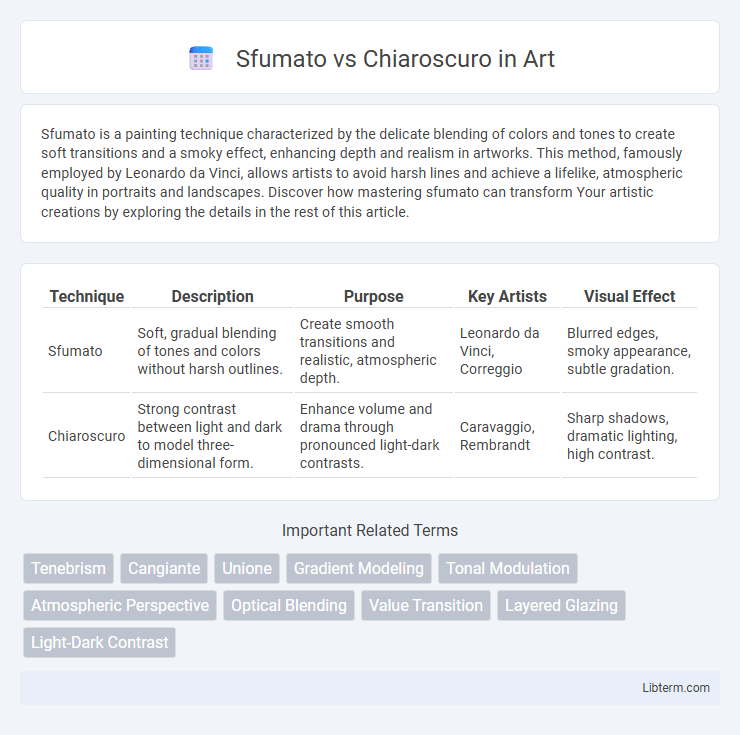Sfumato is a painting technique characterized by the delicate blending of colors and tones to create soft transitions and a smoky effect, enhancing depth and realism in artworks. This method, famously employed by Leonardo da Vinci, allows artists to avoid harsh lines and achieve a lifelike, atmospheric quality in portraits and landscapes. Discover how mastering sfumato can transform Your artistic creations by exploring the details in the rest of this article.
Table of Comparison
| Technique | Description | Purpose | Key Artists | Visual Effect |
|---|---|---|---|---|
| Sfumato | Soft, gradual blending of tones and colors without harsh outlines. | Create smooth transitions and realistic, atmospheric depth. | Leonardo da Vinci, Correggio | Blurred edges, smoky appearance, subtle gradation. |
| Chiaroscuro | Strong contrast between light and dark to model three-dimensional form. | Enhance volume and drama through pronounced light-dark contrasts. | Caravaggio, Rembrandt | Sharp shadows, dramatic lighting, high contrast. |
Introduction to Sfumato and Chiaroscuro
Sfumato and Chiaroscuro are two pivotal techniques in Renaissance art that manipulate light and shadow to enhance realism and depth. Sfumato involves the delicate blending of colors and tones to create soft transitions without harsh lines, exemplified in Leonardo da Vinci's works. Chiaroscuro emphasizes strong contrasts between light and dark, generating dramatic three-dimensional effects, notably utilized by artists like Caravaggio.
Defining Sfumato: The Art of Soft Transitions
Sfumato is a painting technique characterized by soft, gradual transitions between colors and tones, creating a smoky, blurred effect without harsh lines. It enhances the perception of depth and volume, often used to render lifelike skin textures and atmospheric backgrounds. Unlike chiaroscuro, which emphasizes strong contrasts between light and dark, sfumato relies on subtle blending to achieve a delicate, almost ethereal realism.
Understanding Chiaroscuro: Light and Shadow in Art
Chiaroscuro is a technique that emphasizes the dramatic contrast between light and shadow to create depth and volume in artwork, enhancing the three-dimensionality of subjects. Unlike sfumato, which uses soft transitions and blurred edges to achieve a smoky effect, chiaroscuro relies on stark illumination contrasts to highlight form and texture. This method was notably employed by artists such as Caravaggio and Rembrandt to evoke emotional intensity and realism through strategic light placement.
Historical Origins and Artistic Roots
Sfumato, developed during the High Renaissance by Leonardo da Vinci, originated from experimentation with soft transitions between colors and tones to create lifelike, smoky effects in portraits. Chiaroscuro traces back to early Renaissance artists like Giorgione and Caravaggio, emphasizing dramatic contrasts between light and shadow to add depth and volume to figures and scenes. Both techniques reflect significant advancements in understanding light manipulation and anatomy in Western art history.
Techniques Used in Sfumato Painting
Sfumato painting technique employs delicate blending of colors and tones to create soft transitions without visible brushstrokes, enhancing depth and volume by mimicking natural light and shadow diffusions. This method involves layering thin glazes of translucent paint, typically oil, to achieve a smoky, hazy effect that produces subtle gradations between highlights and shadows. Unlike chiaroscuro, which emphasizes strong contrasts and sharp edges, sfumato focuses on gradual tonal shifts to achieve a lifelike, three-dimensional appearance.
Chiaroscuro Methods: Creating Dramatic Contrast
Chiaroscuro methods emphasize the use of strong contrasts between light and dark to create dramatic depth and volume in artwork. Techniques involve manipulating shading and lighting gradients to highlight form and evoke intense emotional impact. Mastery of chiaroscuro allows artists to enhance three-dimensionality and realism by balancing illuminated areas against deep shadows.
Key Artists: Leonardo da Vinci vs Caravaggio
Leonardo da Vinci pioneered sfumato, a technique characterized by soft transitions between colors and tones, creating a smokey, atmospheric effect that enhances naturalism in portraits like the Mona Lisa. Caravaggio, a master of chiaroscuro, employed stark contrasts between light and dark to produce dramatic intensity and three-dimensionality in works like The Calling of Saint Matthew. Both artists revolutionized Renaissance art through their distinct use of light and shadow, with da Vinci emphasizing subtle gradations and Caravaggio highlighting bold contrasts.
Famous Artworks Showcasing Each Technique
Leonardo da Vinci's "Mona Lisa" exemplifies sfumato with its soft transitions between light and shadow, creating a lifelike, atmospheric effect. In contrast, Caravaggio's "The Calling of Saint Matthew" demonstrates chiaroscuro through dramatic contrasts of light and dark, emphasizing depth and intensity. These masterpieces highlight how sfumato blends tonal gradations while chiaroscuro accentuates sharp, theatrical lighting.
Impact on Renaissance and Baroque Art
Sfumato and chiaroscuro significantly shaped Renaissance and Baroque art by manipulating light and shadow to create depth and realism. Sfumato, pioneered by Leonardo da Vinci, produced soft transitions between colors and tones, enhancing naturalism in Renaissance portraits. Chiaroscuro, emphasized in Baroque art by artists like Caravaggio, used stark contrasts to evoke drama, emotional intensity, and three-dimensional effects.
Sfumato vs Chiaroscuro: Modern Relevance and Legacy
Sfumato and chiaroscuro, both Renaissance painting techniques, remain influential in modern art and visual storytelling, with sfumato emphasizing subtle gradations of tone and chiaroscuro focusing on stark light-dark contrasts to create depth and drama. Contemporary digital artists and filmmakers adopt sfumato to achieve realistic shading and soft transitions, while chiaroscuro is widely used to convey mood and highlight subject intensity through bold lighting. The legacy of both techniques persists in graphic design and cinematography, underpinning modern aesthetics by enhancing visual narratives with nuanced texture and dramatic emphasis.
Sfumato Infographic

 libterm.com
libterm.com